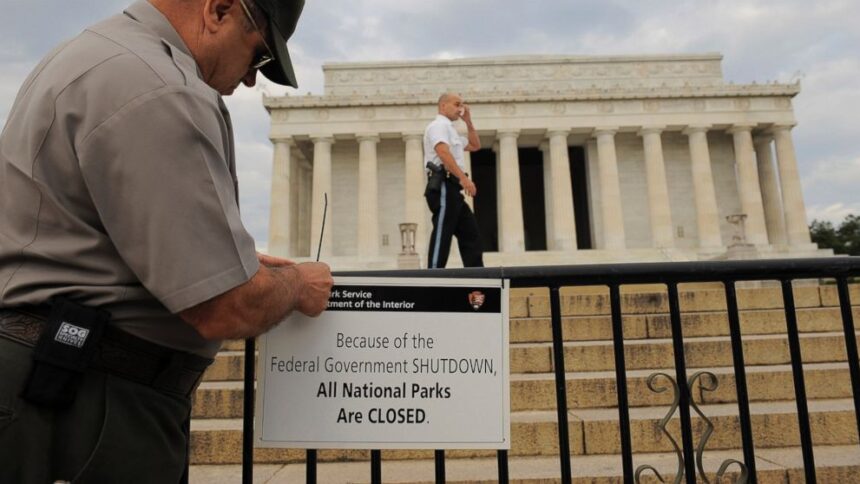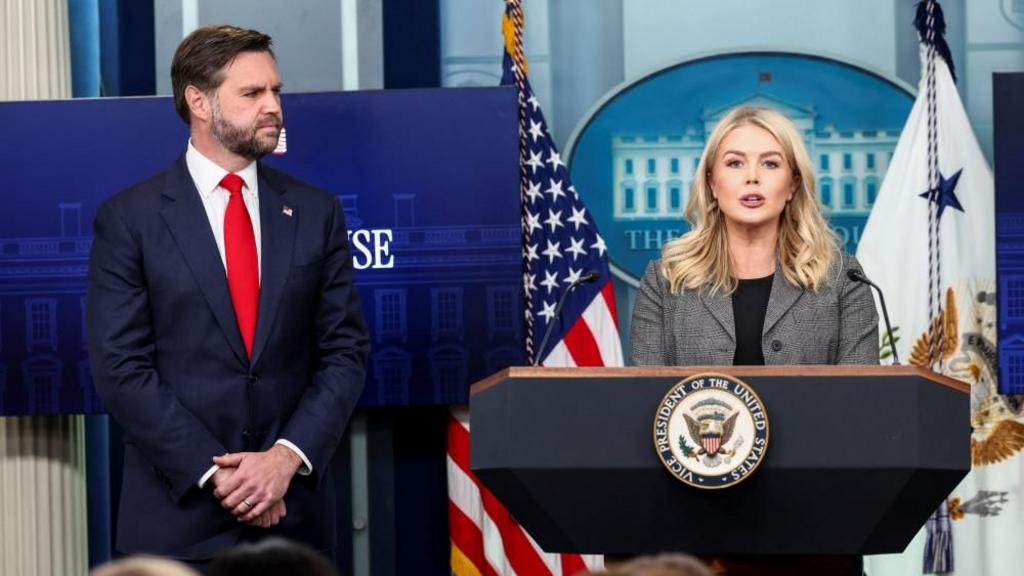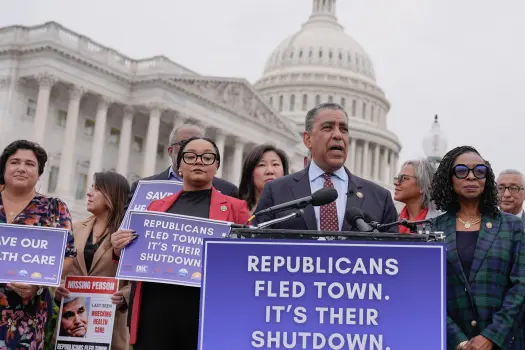WASHINGTON D.C. – The first federal government shutdown since 2019 reached its second day, leaving the U.S. Capitol unusually quiet. The iconic dome reflected in the rain under a cloudy October sky. Non-essential government functions have stopped, causing furloughs for hundreds of thousands of federal employees.
Delays affect many operations, including national park services and the release of important economic information. The standoff pivots on a sharp disagreement over healthcare subsidies and spending priorities. Republicans are threatening unprecedented mass layoffs to try and force the Democrats to comply.
The Federal Government Shutdown started at 12:01 a.m. on October 1. This happened after Congress failed to approve necessary funding before the fiscal year concluded on September 30. A continuing resolution (CR) proposed by Republicans would have extended funding until November 21.
It passed the House but stalled in the Senate. Democrats blocked the measure, primarily along party lines. They demanded extensions for the Affordable Care Act (ACA) subsidies scheduled to expire at the end of the year. Democrats then offered their own alternative.
This proposal would have reversed recent Medicaid reductions from the GOP’s “One Big Beautiful Bill Act” and maintained increased premium tax credits. The Republican side rejected this plan quickly.
The consequences are significant. If Congress does not act, premiums for ACA marketplace plans could soar by 75 per cent on average in 2026. This potential increase affects 24 million Americans.
Many of these people live in areas that tend to support Republicans, such as Florida and Texas, which have resisted Medicaid expansion. Senator Patty Murray (D-Wash.), the ranking member of the Senate Appropriations Committee, spoke on the floor Tuesday.
She stated the issue goes beyond politics; it affects families forced to choose between groceries and vital medication like insulin.
Republicans Seek Advantage with Firings During Federal Government Shutdown
President Donald Trump and his supporters have used this situation to push their long-term goals for government efficiency. Last week, the Office of Management and Budget (OMB) issued a memo. Director Russell Vought leads the OMB.
The memo told agencies to prepare “reduction in force” (RIF) plans. These plans call for permanent layoffs targeting non-essential programs that do not align with the administration’s goals. Unlike typical shutdown furloughs, which are temporary and workers receive back pay, these RIFs would permanently eliminate jobs.
On Wednesday, Vought spoke to House Republicans virtually. He warned that widespread layoffs might begin within a day or two if the shutdown continued. Attendees reported Vought saying they were not just pausing; they were trimming the large bureaucracy that has supposedly held America back too long.
The plan safeguards essential services like Social Security payments, military operations, and border security. However, it targets areas such as environmental initiatives and diversity programs.
Trump reinforced this position during a White House press briefing. He joked that shutdowns could bring positive results by eliminating things the administration did not want, which he characterized as Democrat priorities.
Vice President JD Vance blamed the stalemate on a “far-left faction” of Senate Democrats. He praised moderate Democrats who voted for the GOP’s CR. Senate Majority Leader John Thune (R-S.D.) dismissed the Democrats’ demands as a “temper tantrum.” He insisted they should vote to open the government, and the issue would disappear.
The administration immediately demonstrated its resolve. On the first day, the White House froze $26 billion in funding for states that lean Democratic. This included $18 billion for New York infrastructure improvements and $8 billion for renewable energy projects across sixteen blue states. Some critics, including Senator Thom Tillis (R-N.C.), cautioned that this could worsen the political atmosphere and extend the crisis.
The public reaction has been quick and divided. On X (formerly Twitter), conservative users praised the moves as shedding unnecessary weight from federal overreach. One post advocated for the mass firings to start because it was time to shed the weight.
Polls indicate that 55 per cent of Americans, including one quarter of Democrats, generally support downsizing the federal workforce. However, support drops significantly when those views are tied to immediate job losses.
Democrats Reject Ultimatum, Call it “Their Federal Government Shutdown”
Democratic leaders have not backed down from the layoff threats. They have characterized the Federal Government shutdown as a Republican effort to dismantle social programs. Senate Minority Leader Chuck Schumer (D-N.Y.) released a statement after midnight, joined by House Minority Leader Hakeem Jeffries (D-N.Y.). They argued that since Republicans control the White House, the House, and the Senate, this is their shutdown.
The leaders accused the GOP of making crucial services unavailable due to policy disagreements, especially regarding ACA subsidies that have helped double enrollment since 2021.
Representative Alexandria Ocasio-Cortez (D-N.Y.) appeared on MSNBC, calling Trump’s actions a “bluffing game.” She added that he is holding the federal workforce captive by threatening to fire everyone.
Senator Elizabeth Warren (D-Mass.) used a viral video to make a stronger statement. She claimed Donald Trump shut down the government because he prefers raising health premiums by 75 per cent instead of reducing costs for families.
Similarly, X users popularized the hashtag, calling it #TRUMPSHUTDOWN2025 and asserting that Trump intended this to reduce the workforce.
Labour unions, which represent vast numbers of federal workers, filed lawsuits in federal court on Wednesday. They seek to block the mass firings, calling them “illegal” and a misuse of power during a shutdown.
AFL-CIO President Liz Shuler urged Congress to fund the government, resolve the healthcare crisis, and prioritize working people. The American Federation of Government Employees (AFGE) agreed, criticizing Vought’s plans for adding chaos to an already disruptive shutdown.
A small group of moderate senators rejected the majority Democratic position. Senators John Fetterman (D-Pa.), Catherine Cortez Masto (D-Nev.), and independent Angus King (I-Maine) voted for the GOP’s CR. They called the shutdown a “sad day” and encouraged reaching an agreement.
Nevertheless, most Democrats remain united on the Federal Government Shutdown. They are betting that public frustration over delayed WIC nutrition assistance for mothers and children, unpaid TSA agents during busy travel times, and closed national parks will put pressure on Republicans.
The consequences for Americans are already increasing. Congressional Budget Office forecasts suggest up to 750,000 federal employees face daily furloughs. NASA’s 15,000 workers were among the first affected. National parks stay open but lack sufficient staff, a situation that risks safety and maintenance. The Bureau of Labour Statistics postponed its October 3 jobs report, and food banks are preparing for greater need as WIC funding runs out.
Experts predict the shutdown could last several weeks, perhaps matching the 35-day impasse of 2018-2019. Historically, compromises occur only when the economic hardship becomes too much to bear. Losses are estimated at $1.5 billion daily. Republicans may agree to the healthcare subsidies to avoid a backlash in the next election. Democrats risk alienating moderate voters if the mass firings go forward.
For now, the arguments continue. Furloughed employees, such as USDA worker Elizabeth Riley, are rallying on Capitol Hill. They say they are not pawns in a political game. In a divided Washington, one clear fact remains: the only people truly losing are the American citizens waiting for the government to resume normal operations.
















